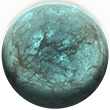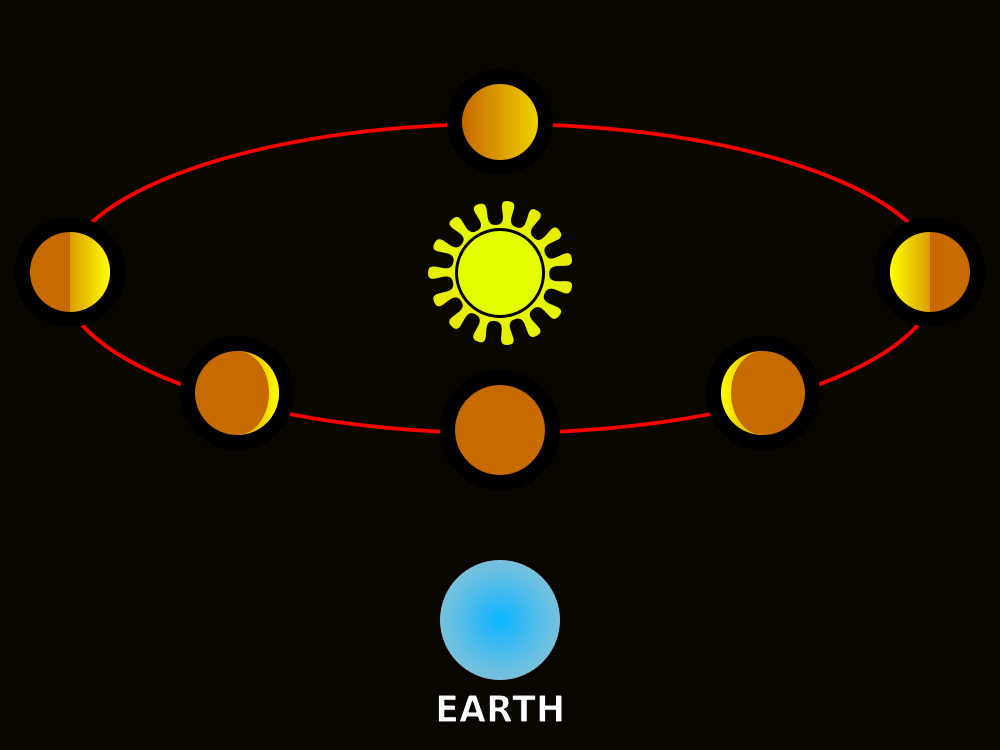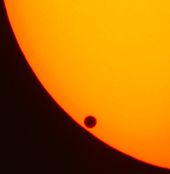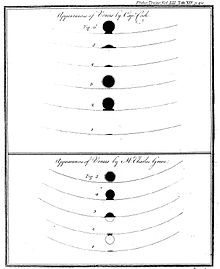Rough Notes:
Orbit and rotation
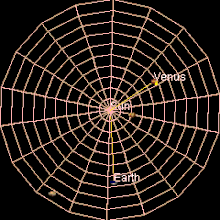
Venus orbits the Sun at an average distance of about 108 million kilometres (about 0.7 AU) and completes an orbit every 224.7 days. Venus is the second planet from the Sun and orbits the Sun approximately 1.6 times (yellow trail) in Earth's 365 days (blue trail)
Venus orbits the Sun at an average distance of about 0.72 AU (108 million km; 67 million mi), and completes an orbit every 224.7 days. Although all planetary orbits are elliptical, Venus's orbit is the closest to circular, with an eccentricity of less than 0.01.[2] When Venus lies between Earth and the Sun in inferior conjunction, it makes the closest approach to Earth of any planet at an average distance of 41 million km (25 million mi).[2] The planet reaches inferior conjunction every 584 days, on average.[2] Because of the decreasing eccentricity of Earth's orbit, the minimum distances will become greater over tens of thousands of years. From the year 1 to 5383, there are 526 approaches less than 40 million km; then there are none for about 60,158 years.[96]
All the planets in the Solar System orbit the Sun in an anti-clockwise direction as viewed from above Earth's north pole. Most planets also rotate on their axes in an anti-clockwise direction, but Venus rotates clockwise in retrograde rotationonce every 243 Earth days—the slowest rotation of any planet. Because its rotation is so slow, Venus is very close to spherical.[97] A Venusian sidereal day thus lasts longer than a Venusian year (243 versus 224.7 Earth days). Venus's equator rotates at 6.52 km/h (4.05 mph), whereas Earth's rotates at 1,669.8 km/h (1,037.6 mph).[98] Venus's rotation has slowed down in the 16 years between the Magellan spacecraft and Venus Express visits; each Venusian sidereal day has increased by 6.5 minutes in that time span.[99] Because of the retrograde rotation, the length of a solar day on Venus is significantly shorter than the sidereal day, at 116.75 Earth days (making the Venusian solar day shorter than Mercury's 176 Earth days).[100] One Venusian year is about 1.92 Venusian solar days.[101] To an observer on the surface of Venus, the Sun would rise in the west and set in the east,[101] although Venus's opaque clouds prevent observing the Sun from the planet's surface.[102]
Venus may have formed from the solar nebula with a different rotation period and obliquity, reaching its current state because of chaotic spin changes caused by planetary perturbations and tidal effects on its dense atmosphere, a change that would have occurred over the course of billions of years. The rotation period of Venus may represent an equilibrium state between tidal locking to the Sun's gravitation, which tends to slow rotation, and an atmospheric tide created by solar heating of the thick Venusian atmosphere.[103][104] The 584-day average interval between successive close approaches to Earth is almost exactly equal to 5 Venusian solar days,[105] but the hypothesis of a spin–orbit resonance with Earth has been discounted.[106]
Venus has no natural satellites.[107] It has several trojan asteroids: the quasi-satellite 2002 VE68[108][109] and two other temporary trojans, 2001 CK32 and 2012 XE133.[110] In the 17th century, Giovanni Cassini reported a moon orbiting Venus, which was named Neith and numerous sightings were reported over the following 200 years, but most were determined to be stars in the vicinity. Alex Alemi's and David Stevenson's 2006 study of models of the early Solar System at the California Institute of Technology shows Venus likely had at least one moon created by a huge impact event billions of years ago.[111] About 10 million years later, according to the study, another impact reversed the planet's spin direction and caused the Venusian moon gradually to spiral inward until it collided with Venus.[112] If later impacts created moons, these were removed in the same way. An alternative explanation for the lack of satellites is the effect of strong solar tides, which can destabilize large satellites orbiting the inner terrestrial planets.[107]
Observation
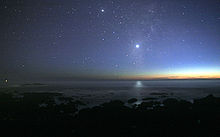
Venus is always brighter than all other planets or stars as seen from Earth. The second brightest object on the image is Jupiter.
To the naked eye, Venus appears as a white point of light brighter than any other planet or star (apart from the Sun).[113] Its brightest apparent magnitude, −4.9,[10] occurs during crescent phase, only 36 days before or after inferior conjunction.[114] Venus will be brightest on 30 April 2017, then grow dimmer for nearly a year. Venus fades to about magnitude −3 when it is backlit by the Sun.[9] The planet is bright enough to be seen in a clear midday sky[115] and is more easily visible when the Sun is low on the horizon or setting. As an inferior planet, it always lies within about 47° of the Sun.[11]
Venus "overtakes" Earth every 584 days as it orbits the Sun.[2] As it does so, it changes from the "Evening Star", visible after sunset, to the "Morning Star", visible before sunrise. Although Mercury, the other inferior planet, reaches a maximum elongation of only 28° and is often difficult to discern in twilight, Venus is hard to miss when it is at its brightest. Its greater maximum elongation means it is visible in dark skies long after sunset. As the brightest point-like object in the sky, Venus is a commonly misreported "unidentified flying object".
Phases

The phases of Venus and evolution of its apparent diameter
As it orbits the Sun, Venus displays phases like those of the Moon in a telescopic view. The planet appears as a small and "full" disc when it is on the opposite side of the Sun (at superior conjunction). Venus shows a larger disc and "quarter phase" at its maximum elongations from the Sun, and appears its brightest in the night sky. The planet presents a much larger thin "crescent" in telescopic views as it passes along the near side between Earth and the Sun. Venus displays its largest size and "new phase" when it is between Earth and the Sun (at inferior conjunction). Its atmosphere is visible through telescopes by the halo of sunlight refracted around it.[11]
Transits
The Venusian orbit is slightly inclined relative to Earth's orbit; thus, when the planet passes between Earth and the Sun, it usually does not cross the face of the Sun. Transits of Venus occur when the planet's inferior conjunction coincides with its presence in the plane of Earth's orbit. Transits of Venus occur in cycles of 243 years with the current pattern of transits being pairs of transits separated by eight years, at intervals of about 105.5 years or 121.5 years—a pattern first discovered in 1639 by the English astronomer Jeremiah Horrocks.[116]
The latest pair was June 8, 2004 and June 5–6, 2012. The transit could be watched live from many online outlets or observed locally with the right equipment and conditions.[117]
The preceding pair of transits occurred in December 1874 and December 1882; the following pair will occur in December 2117 and December 2125.[118] The oldest film known is the 1874 Passage de Venus, showing the 1874 Venus transit of the sun. Historically, transits of Venus were important, because they allowed astronomers to determine the size of the astronomical unit, and hence the size of the Solar System as shown by Horrocks in 1639.[119] Captain Cook's exploration of the east coast of Australia came after he had sailed to Tahiti in 1768 to observe a transit of Venus.[120][121]
Pentagram of Venus

The pentagram of Venus. Earth is positioned at the centre of the diagram, and the curve represents the direction and distance of Venus as a function of time.
The pentagram of Venus is the path that Venus makes as observed from Earth. Successive inferior conjunctions of Venus repeat very near a 13:8 orbital resonance (Earth orbits 8 times for every 13 orbits of Venus), shifting 144° upon sequential inferior conjunctions. The resonance 13:8 ratio is approximate. 8/13 is approximately 0.615385 while Venus orbits the Sun in 0.615187 years.[122]
Daylight apparitions
Naked eye observations of Venus during daylight hours exist in several anecdotes and records. Astronomer Edmund Halley calculated its maximum naked eye brightness in 1716, when many Londoners were alarmed by its appearance in the daytime. French emperor Napoleon Bonaparte once witnessed a daytime apparition of the planet while at a reception in Luxembourg.[123] Another historical daytime observation of the planet took place during the inauguration of the American president Abraham Lincoln in Washington, D.C., on 4 March 1865.[124] Although naked eye visibility of Venus' phases is disputed, records exist of observations of its crescent.[125]
Ashen light
A long-standing mystery of Venus observations is the so-called ashen light—an apparent weak illumination of its dark side, seen when the planet is in the crescent phase. The first claimed observation of ashen light was made in 1643, but the existence of the illumination has never been reliably confirmed. Observers have speculated it may result from electrical activity in the Venusian atmosphere, but it could be illusory, resulting from the physiological effect of observing a bright, crescent-shaped object.[126][38]
Studies
Early studies
Venus was known to ancient civilizations both as the "morning star" and as the "evening star", names that reflect the early assumption that these were two separate objects. The ancient Sumerians, who recognized Venus as a single object,[127] believed that it was their goddess Inanna.[127][128][129] Inanna's movements in several of her myths, including Inanna and Shukaletuda and Inanna's Descent into the Underworld appear to parallel the motion of the planet Venus.[127] The Venus tablet of Ammisaduqa, believed to have been compiled around the mid-seventeenth century BCE,[130] shows the Babylonians understood the two were a single object, referred to in the tablet as the "bright queen of the sky", and could support this view with detailed observations.[131]
The ancient Greeks thought that Venus was two separate stars: Phosphorus and Hesperus. Pliny the Elder credited the realization that they were a single object to Pythagoras in the sixth century BCE,[132] while Diogenes Laertius argued that Parmenides was probably responsible.[133] The ancient Chinese referred to the morning Venus as "the Great White" (Tai-bai 太白) or "the Opener (Starter) of Brightness" (Qi-ming 啟明), and the evening Venus as "the Excellent West One" (Chang-geng 長庚). The Romans designated the morning aspect of Venus as Lucifer, literally "Light-Bringer", and the evening aspect as Vesper, both literal translations of the respective Greek names.
In the second century, in his astronomical treatise Almagest, Ptolemy theorized that both Mercury and Venus are located between the Sun and the Earth. The 11th century Persian astronomer Avicenna claimed to have observed the transit of Venus,[134] which later astronomers took as confirmation of Ptolemy's theory.[135] In the 12th century, the Andalusian astronomer Ibn Bajjah observed "two planets as black spots on the face of the Sun", which were later identified as the transits of Venus and Mercury by the Maragha astronomer Qotb al-Din Shirazi in the 13th century.[136][n 2]
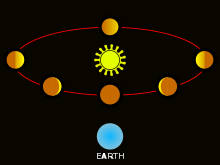
Galileo's discovery that Venus showed phases (although remaining near the Sun in Earth's sky) proved that it orbits the Sun and not Earth
When the Italian physicist Galileo Galilei first observed the planet in the early 17th century, he found it showed phases like the Moon, varying from crescent to gibbous to full and vice versa. When Venus is furthest from the Sun in the sky, it shows a half-lit phase, and when it is closest to the Sun in the sky, it shows as a crescent or full phase. This could be possible only if Venus orbited the Sun, and this was among the first observations to clearly contradict the Ptolemaic geocentric model that the Solar System was concentric and centred on Earth.[139][140]
The 1639 transit of Venus was accurately predicted by Jeremiah Horrocks and observed by him and his friend, William Crabtree, at each of their respective homes, on 4 December 1639 (24 November under the Julian calendar in use at that time).[141]
The atmosphere of Venus was discovered in 1761 by Russian polymath Mikhail Lomonosov.[142][143] Venus's atmosphere was observed in 1790 by German astronomer Johann Schröter. Schröter found when the planet was a thin crescent, the cusps extended through more than 180°. He correctly surmised this was due to scattering of sunlight in a dense atmosphere. Later, American astronomer Chester Smith Lyman observed a complete ring around the dark side of the planet when it was at inferior conjunction, providing further evidence for an atmosphere.[144] The atmosphere complicated efforts to determine a rotation period for the planet, and observers such as Italian-born astronomer Giovanni Cassini and Schröter incorrectly estimated periods of about 24 h from the motions of markings on the planet's apparent surface.[145]
Ground-based research
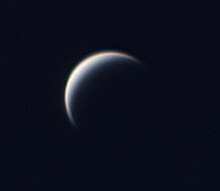
Modern telescopic view of Venus from Earth's surface
Little more was discovered about Venus until the 20th century. Its almost featureless disc gave no hint what its surface might be like, and it was only with the development of spectroscopic, radar and ultraviolet observations that more of its secrets were revealed. The first ultraviolet observations were carried out in the 1920s, when Frank E. Ross found that ultraviolet photographs revealed considerable detail that was absent in visible and infrared radiation. He suggested this was due to a dense, yellow lower atmosphere with high cirrus clouds above it.[146]
Spectroscopic observations in the 1900s gave the first clues about the Venusian rotation. Vesto Slipher tried to measure the Doppler shift of light from Venus, but found he could not detect any rotation. He surmised the planet must have a much longer rotation period than had previously been thought.[147] Later work in the 1950s showed the rotation was retrograde. Radar observations of Venus were first carried out in the 1960s, and provided the first measurements of the rotation period, which were close to the modern value.[148]
Radar observations in the 1970s revealed details of the Venusian surface for the first time. Pulses of radio waves were beamed at the planet using the 300 m (980 ft) radio telescope at Arecibo Observatory, and the echoes revealed two highly reflective regions, designated the Alpha and Beta regions. The observations also revealed a bright region attributed to mountains, which was called Maxwell Montes.[149] These three features are now the only ones on Venus that do not have female names.[32]
Venus in Transition
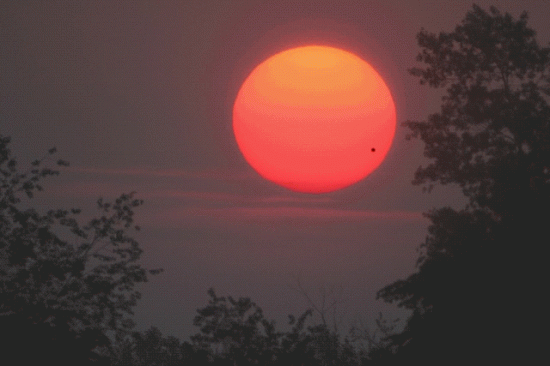
Venus passed in front of the Sun on June 8, 2004. Credit: Dan Lazzlo
Nov 22, 2012
Venus will transit the Sun on June 5, 2012.
Venus and Earth describe a unique orbital configuration with respect to the Sun. The resonance between the two planets is readily apparent when a plot of their movements is made over the course of eight years.
Every couple of centuries, the two planets are in close enough alignment that Venus crosses the face of the Sun twice in eight years. Between that pair of crossings, there is a gap of 121.5 years, then two transits in eight years, then a gap of 105.5 years, then two transits, then a gap of 121.5 years, and so on. Why this odd time interval?
Beginning with a transit alignment, as Venus and Earth orbit the Sun, Venus laps Earth in its orbit after 1.6 Earth years, or 2.6 Venusian years. The fifth time that Venus catches up with Earth, after eight years, they are back at their starting point again. The reason there is no transit every eight years is that the orbit of Venus is inclined to the plane of the ecliptic, taking it slightly above or below a line-of-sight with Earth.
After five Venus-Earth conjunctions, they are also slightly clockwise from their starting positions. It takes 105.5 and 121.5 years for them to regress to their eight year transit pairs and shift from June to December. In 2117, Venus will perform during early December.
Thus, Venus is in near resonance with Earth. In order for an exact orbital resonance to exist, Venus would have to revolve in 243.16 days, but its actual period is 243.01 days. This close alignment suggests that it might be moving out of a resonant pattern that once was more precise.
One factor besides gravity that might contribute to its face-to-face dance with Earth is that Venus has a long ion tail that extends outward for more than 45 million kilometers. During inferior conjunction, that electrically charged structure can interact with our magnetosphere. What if that electrical connection was much stronger in the past?
Venus is evidently a young planet, since it retains a dense, hot atmosphere. It also retains some of the cometary characteristics that were probably visible to ancient civilizations. Electric Universe theorist Wal Thornhill writes:
“Venus, with its cometary tail, is evidently still discharging strongly today after a recent cometary past noted globally by ancient witnesses. Venus was described variously as a ‘hairy star’ or ‘bearded star’ and a stupendous prodigy in the sky. Today, Venus’ comet tail operates in the dark discharge mode and is invisible. It can only be detected by magnetometers and charged particle detectors.”
Venus is supposed to have condensed out of the same primordial cloud as the rest of the planets in the Solar System billions of years ago. Most planetary scientists agree that it has been as it is for at least 300 million years. That means the surface of Venus has been subjected to chemical erosion for hundreds of millions of years.
Why is there no sign of any significant erosion? The Russian Venera landing craft discovered that the surface of Venus is bare rock, with a little debris inside the cracks. This is a significant anomaly for which no one has offered a theory. If its entire surface has been renovated in the last 300 million years, what caused that to happen?
Once, perhaps as little as 5000 years ago, the planets were seen as veritable gods, with tremendous powers and chaotic aspects. Those godlike luminaries cast violent energies upon each other and upon Earth: boiling seas, melting mountain ranges, raising sky high tornadoes of fire, and hurling lightning bolts sufficient to vaporize any human work.
The planet-gods did not revolve in the stately orbits we see today. Instead, they encroached on each other, looming large and then retreating, only to rush together in conflict again. During those encounters, Venus and Earth exchanged gigantic outbursts of electric discharge. In those bolts of interplanetary lightning they formed an electromagnetic bond. It was probably then that the orbital resonance that both planets share came into existence.
As time passes, the intimate relationship once shared by Gaea and Aphrodite is beginning to fade. The long ion tail of Venus that continues to brush Earth with its faint electric tickle indicates that it is still in a state of discharge as it slowly regains equilibrium with the Solar System’s overall balance. The past appearance of Venus as a terrifying comet with fire-like tendrils and monstrous features has been detailed elsewhere in these pages. For now, let it be said that the goddess is sleeping, and in her slumber we are drifting apart.
Stephen Smith
Editor’s note: The link to a plot of the Venus-Earth relationship is from A Little Book of Coincidence by John Martineau
|
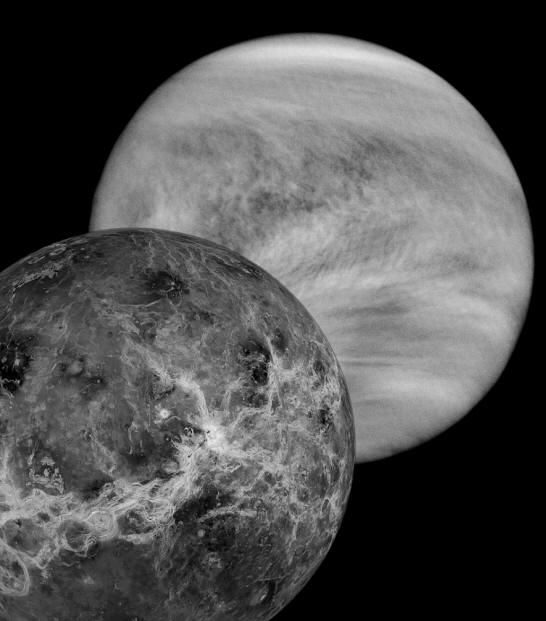
Venus in radar wavelengths and in visible light. Credit: NASA/JPL/RPIF/DLR.
Venus in Lockstep
Sep 22, 2010
It has long been known that Venus and Earth are somehow gravitationally bound.
According to a recent press release, an old theory about the resonant orbits of Venus and Earth has been resurrected. Whenever Venus arrives at its closest approach to Earth, called an inferior conjunction, it always turns the same face toward our planet. The implication of that arrangement is that Earth and its sister planet are exerting some kind of influence on each other. Since there is no other force known to astronomers that can act between planets, that influence must be gravitational.
An inferior conjunction of Venus takes place when it is aligned between Earth and the Sun. At that time, it is approximately 41 million kilometers away from our planet. However, planetary scientists insist that gravity is too weak to form a resonant lock, leading to an Electric Universe theory that the two planets were once much closer.
Venus is actually in near resonance with Earth. In order for an exact orbital resonance to exist, Venus would have to rotate in 243.16 days, but its actual period is 243.01 days. This close alignment suggests that it might be moving out of a resonant pattern that was once more precise.
One factor besides gravity that might contribute to its face-to-face dance with Earth is that Venus has a long ion tail that extends outward for more than 45 million kilometers. During inferior conjunction, that electrically charged structure can interact with our magnetosphere. What if that electrical connection was much stronger in the past?
Venus is evidently a young planet and still retains some of the cometary characteristics that were once visible to the ancients. Electric Universe theorist Wal Thornhill writes:
"Venus, with its cometary tail, is evidently still discharging strongly today after a recent cometary past noted globally by ancient witnesses. Venus was described variously as a ‘hairy star’ or ‘bearded star’ and a stupendous prodigy in the sky. Today, Venus’ comet tail operates in the dark discharge mode and is invisible. It can only be detected by magnetometers and charged particle detectors."
More than 60 years ago, a radical new approach to Solar System dynamics was placed in the public record by a brilliantly inventive scientist, Immanuel Velikovsky. Although various details of his theory have been revised in light of recent discoveries, his essential premise continues to inspire others, including this reporter, to pursue further insights. Prior to the Solar System we know today, there was another arrangement whose downfall became manifest in the mythology of every civilization able to record it for posterity.
Once, perhaps as little as 5000 years ago, the planets were seen as veritable gods, with tremendous powers and chaotic aspects. Those godlike luminaries cast violent energies upon each other and upon Earth: boiling seas, melting mountain ranges, raising sky high tornadoes of fire, and hurling lightning bolts sufficient to vaporize any human work.
The planet-gods did not revolve in the stately orbits we see today. Instead, they encroached on each other, looming large and then retreating, only to rush together in conflict again. During those encounters, Venus and Earth exchanged gigantic outbursts of electric discharge. In those bolts of interplanetary lightning they formed an electromagnetic bond. It was probably then that the orbital resonance that both planets share came into existence.
As time passes, the intimate relationship once shared by Gaea and Aphrodite is beginning to fade. The long ion tail of Venus that continues to brush Earth with its faint electric tickle indicates that it is still in a state of discharge as it slowly regains equilibrium with the Solar System's overall balance. The past appearance of Venus as a terrifying comet with fire-like tendrils and monstrous features has been detailed elsewhere in these pages. For now, let it be said that the goddess is sleeping, and in her slumber we are drifting apart.
Stephen Smith
|
|
|

